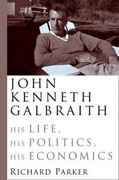If one individual could be singled out as the “economist of the American Century,” John Kenneth Galbraith would certainly be a prime candidate. During the course of his long life, which spans most of the 20th century to the present day, Galbraith has filled many roles: economic thinker, government official, diplomat, writer and star of his own “Age of Uncertainty” television series on PBS.
During the summer of 1971, President Richard Nixon cast Galbraith in a far different role, as an “expletive deleted” enemy of American free enterprise.
In a vividly recounted incident in Richard Parker’s compelling and thoughtful biography of Galbraith — John Kenneth Galbraith: His Life, His Politics, His Economics (Farrar, Strauss, Giroux) — Nixon fixed his hostility on Galbraith as the floundering U.S. economy and plunging confidence in the dollar began to undermine his presidency. The level of contempt Nixon had for the “chief economic guru” of the Democrats says as much about Galbraith’s public stature as the president’s psychological state of mind.
Nixon met on July 28 with Treasury Secretary John Connally and a number of aides in a strategy session that was a prelude for the imposition of controversial wage and price controls a few days later. Nixon rambled and fumed throughout much of the meeting but he made his antipathy to Galbraith “perfectly clear.” Alluding to a favorite adage of Connally, Nixon said: “The next time out, whenever you have the opportunity — I know you often use your principle, ‘It’s nice to have an enemy’ — well, one of the best ones I can think of is John Kenneth Galbraith.”
Nixon was far from the first to think of Galbraith in adversarial terms. Galbraith numbered among his foes such distinguished figures as Harvard President James Conant, President Lyndon Johnson during the Vietnam War and rival economist Milton Friedman. At the center of many of the major economic and political controversies of his day, the erudite and determined Galbraith was bound to make enemies — and did.
Rival Camps in the Keynesian School
Yet Parker’s biography of Galbraith is much more than a retelling of old political war stories. It is a balanced appraisal of a major economic and social thinker and the clash of great economic theories in which he played such a notable part. The intellectual battleground is as important a factor as the political sphere, for Galbraith was a major player in both realms. Parker does equal justice to both.
A senior fellow at Harvard’s Kennedy School of Government and co-founder of the magazine Mother Jones, Parker has the credentials necessary for grappling with the complicated nuances of economic theory and fiscal policy decisions which have figured prominently in Galbraith’s career, particularly the ideas of John Maynard Keynes. Galbraith was one of the foremost advocates of incorporating Keynes’ guiding principles into the economic policies of the U.S. government during the 1930s and after. Enhanced government spending, so Keynes contended, assists the market in achieving fulltime employment, particularly in times of recession. This produces a “multiplier effect” that boosts private consumption and spending to recharge the economy, a vital concern during the “depression decade” of the 1930s.
Galbraith was certainly devoted to Keynes’ belief that government intervention could promote economic growth. Parker, however, notes that within the school of Keynesian thought there was a wide range of differing interpretations. After World War II, the “Keynesian” school split into rival camps: One group used Keynes’ book, The General Theory of Employment, Interest, and Money to press for government action to achieve full employment; their rivals used it to justify government assistance to business to maximize high rates of productivity. Like the Bible, Keynes’ General Theory could be used to support a number of contradictory policies.
Galbraith wisely never became an ideologue of either persuasion. “Pragmatist,” both in politics and economics, comes closest to capturing the spirit of the man.
Pragmatism certainly marked Galbraith’s beginnings. Born in 1908 to a farming family of Scottish descent in Ontario, Galbraith studied agricultural economics at Guelph University and then earned his PhD in economics at the University of California. He secured a teaching position at Harvard in the summer of 1934 after working briefly for the agency established by Franklin Roosevelt’s New Deal to help America’s farmers. The subject which initially preoccupied his lecturing, research and writing was agricultural policy.
Galbraith, however, was not merely teaching “what he knew.” From the very start of his career, he engaged in important public issues. The plight of the embattled American farmer, for example, was of central concern to the New Deal. In commencing his career in the field of agricultural policy, Galbraith was also establishing the leitmotif of his life’s work — the practical application of economics to the lives of the American people, as opposed to formulating abstruse theoretical models.
Parker emphasizes that for Galbraith, economics could never be separated from politics. His own career path was evidence of that. In 1938, Galbraith was caught in the crossfire of bitter dispute when the president of Harvard, James Conant, dismissed two pro-New Deal economics professors. Galbraith was not personally singled out, but the hostility of the Harvard establishment was not hard to discern: Galbraith failed to get tenure.
A few years later, during World War II, when he was the head of the federal Office of Price Administration, commonly referred to as the “price tsar,” his ordeal was more public. With the U.S. at war, Galbraith’s dedicated efforts to prevent abuses of war production costs and rationing should have earned him widespread praise. Instead, he was targeted by right wing critics as “not merely a Communist but a dangerously doctrinaire one,” and forced to resign. The shape of the McCarthy era was already manifesting itself, even before the appearance of its namesake high inquisitor.
After the war, Galbraith served as a member of the Strategic Bombing Survey which analyzed the impact of the Allied air attacks on Nazi Germany’s industrial base. The experience was significant in several ways. Galbraith and his colleagues found that, contrary to the claims of the U.S. Air Force, Germany’s war production rose for much of the period when American and British air attacks were at their fiercest. Needless to say, Galbraith ended up in the middle of a raging controversy.
The real significance of Galbraith’s Strategic Bombing Survey experience was to produce a strong skepticism on his part about claims of military effectiveness. This unsettling assessment grew into a profound awareness of the social and economic effects of vast expenditures on weapons development and large peacetime military establishments which, for the first time, came to dominate the fiscal policy of the U.S in the years following World War II.
Given today’s post-9/11 political-economic situation, Galbraith’s opposition to what President Eisenhower would eventually characterize in 1961 as the “military-industrial complex,” is of particular relevance. The U.S. is facing strong industrial competition at a time when huge sums are being spent to fight terrorist groups with largely conventional military tactics. Will American industrial productivity suffer for want of the government funding that is being allocated instead to the war against terrorism?
Costs of Policing the World
During the 1950s, after he returned to Harvard, Galbraith wrote a series of highly influential and widely read books on America’s economic situation and its social implications. As one of the titles suggested, Galbraith felt that an “affluent society” was indeed possible if public policy concerns like high employment and a rising standard of living were factored into economic planning. In his book, American Capitalism, published in 1951, Galbraith countered concerns that the growing concentration of power among an increasingly select group of big corporations would undermine the foundation of an equitable and affluent society. He unveiled an innovative theory in this book which would confirm him as one of the 20th century’s leading economic thinkers.
Galbraith asserted that countervailing “power” inherent in capitalism would act as a brake on the concentration of economic dominance. Thus, the automobile industry, reduced from a large number of small firms to the “Big Three,” would be checked by the power of the steel industry which supplied its raw materials. “Countervailing power” was Galbraith’s affirmation that a mature free enterprise economy could flourish without constant government deficit spending and regulation.
This was doubly ironic, since Galbraith became the poster boy for “big government” in more minds than Richard Nixon’s. During the 1960s and 1970s, crippling escalations in spending did occur, precisely as Galbraith feared. The “permanent wartime economy,” manifested chiefly in the staggering expenditures on the Vietnam War and the arms race with the Soviet Union, contributed to the paralyzing “stagflation” of the 1970s. Not even an economic superpower like the U.S. could ignore the costs of policing the world. Yet conflicting theories on how to handle “big government,” then and since, seldom addressed the effect of wasteful military spending on economic performance, focusing instead on the costs of social programs.
Galbraith never made that mistake. If a number of his expectations have not come to fruition, like the ability of the “affluent society” to reduce poverty levels, his basic tenets are still valid. In the concluding chapter of his book, Parker assesses the legacy of Galbraith’s ideas. His analysis makes for some very opportune reading. From the time he came to prominence, Galbraith has vigorously asserted that economics “could not be considered in isolation from the human world of politics, institutions and power.” Parker writes of Galbraith’s pragmatic approach to balancing the claims of the U.S. as world power with the public needs of the American people:
“The Galbraithian way out of the dilemma was to fight to restore certain liberal ideas about the public agenda…. Democratic government relies on choices about values, which can’t be made by markets alone. Freedom is essential, but so also are equality, security, social stability, reduced social tensions, and a quality of life that sustains creativity and that focuses the imagination on more than getting and spending.”
It was ideas like this, and the powerful ways that he continues to express them, which put John Kenneth Galbraith on more enemy lists than Richard Nixon. It is the reason, too, why he remains an intellectual force to be reckoned with in the present “Age of Uncertainty.”
| Knowledge at Wharton Summer Reading Collection |
 Summer Reading Special Summer Reading Special A special offer for Knowledge at Wharton readers from Wharton School Publishing » Click here for more information  |



